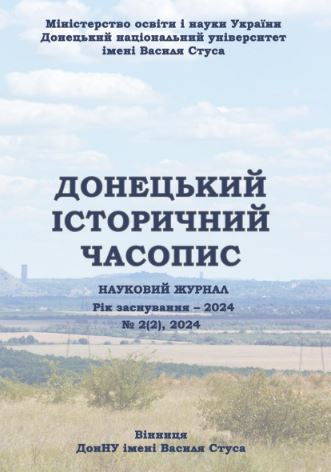The personal dimension of collaboration. Petro Bordychevskyi and the «final solution to the jewish question» in Mariupol
DOI:
https://doi.org/10.31558/3083-5771.2024.2.9Keywords:
Nazi occupation regime, Reichskommissariat Ukraine, collaborationism, Extraordinary State Commission, Mariupol, auxiliary police, Petro BordychevskyiAbstract
The aim of this publication is to shed light on the activities of one of the heads of the Mariupol Auxiliary Police during the Nazi occupation – Petro Bordychevskyi. Based on little-known materials from the archives of Germany and the United States, as well as data from the occupation press, an attempt is made to reconstruct the key moments of P. Bordychevskyi’s life path.
The author emphasizes the need to move away from polarized, black-and-white assessments of local collaborators, a tradition that was shaped by the methodological guidelines of Soviet historiography. The comprehensive involvement of sources of various origins made it possible to accurately reconstruct the course of the second and final stage of the «Final Solution to the Jewish Question» in Mariupol, events that have remained on the periphery of the research interests of local historians, who have mainly focused on the tragedy of the first mass shooting of Mariupol Jews in October 1941. The reliability of Soviet investigative materials concerning Petro Bordychevskyi is questioned, which highlights the need to search for and involve sources of German origin.
The novelty and originality of this study lie in the very formulation of the problem of creating biographical sketches of the most prominent representatives of the regional elites of the occupied territories of Soviet Ukraine, with the goal of reassessing their activities and understanding the goals and motives behind their siding with the «New Order». This article is the first attempt at an overview of Petro Bordychevskyi’s biography against the backdrop of mass repressions against the Jewish population in Mariupol. The prospects for further development of this issue lie in the necessity of creating group portraits of members of the collaborationist formations in Donetsk region during the period of 1941–1943, which also requires the expansion of the current source base through systematic heuristic work in foreign archives.
References
Angrick, A. (2023). Besatzungspolitik und Massenmord. Die Einsatzgruppe D in der südlichen Sowjetunion 1941–1943 [Occupation policy and mass murder. Einsatzgruppe D in the southern Soviet Union 1941–1943]. Hamburg: Hamburger Instituts für Sozialfor-schung [in German].
Aussagen zu Verbrechen in Mariupol [Statements on crimes in Mariupol] (B 162/1261), Bundesarchiv, Koblenz, Germany [in German].
Iarutskii, L. D. (1995). Evrei Priazovia [The Jews of Pryazovia]. Mariupol: Mariupolskoe evreiskoe kulturno-prosvetitelnoe obshchestvo [in Russian].
Ponomarev, L. (1998, October 22). Interview 49617. Interview by Evgenia Davidovna Litinskaya. Visual History Archive, USC Shoah Foundation Retrieved from https://vha-usc-edu.myaccess.library.utoronto.ca/testimony/49617 [in Russian].
Radchenko, Yu. (2017). Ukrainska politsiia ta Holokost na Donbasi [Ukrainian police and the Holocaust in Donbas]. Ukraina Moderna, 24, 64–121 [in Ukrainian].
Reklama [Advertisement]. (1942, 23 veresnia). Mariupolska hazeta, (123), 4 [in Ukrainian].
Romantsov, V. M., Pandazi, A. V., & Huz, A. M. (2018). Trahediia Holokostu v Mariupoli doby natsystskoi okupatsii [The Holocaust tragedy in Mariupol during the period of the Nazi occupation]. Visnyk Mariupolskoho derzhavnoho universytetu. Seriia: istoriia, politolohiia, 22–23, 85–95 [in Ukrainian].
Serdiuk, G. (1998, May 14). Interview 44386. Interview by Evgenia Davidovna Litinskaya. Visual History Archive, USC Shoah Foundation. Retrieved from https://vha-usc-edu.myaccess.library.utoronto.ca/testimony/44386 [in Russian].
Tytarenko, D. (2017). Okupovanyi Mariupol vlitku 1942 r.: za materialamy zvitu polovoi komendatury № 538 [The occupied Mariupol in summer 1942: on base of the report of Field commandant’s office № 538]. Ukraina: kulturna spadshchyna, natsionalna svidomist, derzhavnist, 29, 195–211 [in Ukrainian].
Tytarenko, D. M. (2008). Henotsyd yevreiskoho naselennia na Donechchyni pid chas natsystskoi okupatsii: deiaki dyskusiini aspekty problemy [The genocide of the Jews of Donechchyna during the Nazi occupation: some controversial aspects of the problem]. Novi storinky istorii Donbasu, 15/16, 27–49 [in Ukrainian].

